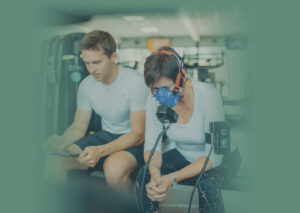These videos were created under our old brand name DYNOSTICS. However, as the content is still valid despite the new brand, you can still find them here!
What is carbohydrate metabolism?
Our body can draw on two different resources to generate energy: Fats and Carbohydrates. Carbohydrates are the most readily available form of energy supply and are available within a few seconds of exercise. Depending on the intensity and duration of the exercise, the body can "switch" between the two types of energy supply. As very intensive exercise leads to increased oxygen consumption, the body must resort to energy production without oxygen during intensive phases, i.e. mainly utilize carbohydrates: this is referred to as the anaerobic threshold. In order to train optimally and avoid acidosis, it is important to know this individual metabolic parameter.
You are currently viewing a placeholder content from Vimeo. To access the actual content, click the button below. Please note that doing so will share data with third-party providers.
More Information
You are currently viewing a placeholder content from Vimeo. To access the actual content, click the button below. Please note that doing so will share data with third-party providers.
More InformationWhat does carbohydrate metabolism mean and why is the carbohydrate metabolism area important for me?
Carbohydrates and fats are utilized in different ways as energy suppliers for the body. While fats are utilized with the help of oxygen (aerobic metabolism), carbohydrates are utilized without oxygen (anaerobic metabolism). Carbohydrate utilization starts immediately after exercise and is the only source of energy available for the first 45 seconds. After that, energy production depends on the intensity of the exercise: If the exertion is very intense, the body needs quickly available energy sources, which it switches on in the form of carbohydrates. If the load changes, it can switch back and forth between the two available energy sources as required.
Intensive physical exertion is accompanied by an "oxygen debt". This means that there is no longer enough oxygen available to cover the current increased demand. Our body now tries to counteract this by increasing the breathing rate - but even this can only compensate for the increased demand to a limited extent. We are all familiar with the effects of such an increased workload: training becomes tiring, we start to pant and have the feeling that we can no longer inhale often enough. If we continue to train in this situation, the body has to manage the energy supply without oxygen, at least for a limited period of time - it draws on stored carbohydrates to do so.
This means that there is always an oxygen debt when we train in the carbohydrate metabolism. An accumulation of the breakdown product lactate and protons then leads to local or systemic hyperacidity - training successes fail to materialize and fatigue sets in: Known symptoms that indicate overtraining.
Exercising too intensively will not achieve sustainable weight loss in the long term.
Intensive training in carbohydrate metabolism initially leads to rapid weight loss success, but the yo-yo effect means that the pounds come back very quickly or the weight reduction stagnates after a short time. Knowing the mechanisms of energy supply and our individual anaerobic threshold - the point at which the body switches from fat to carbohydrate metabolism - helps us to train sustainably and effectively right from the start.
You have questions? Please feel free to Contact us! We are looking forward to your message.







